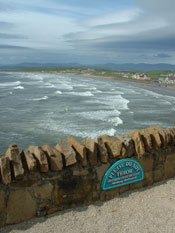Behind the Paper Screen / Japan's 'culture of shame' : The Language Connection : Features : DAILY YOMIURI ONLINE (The Daily Yomiuri): "The Language Connection
The Language Connection Top
I'm not sure how valid the analysis is shame vs. guilt however it does raise a few points of interest for discussion.
Behind the Paper Screen / Japan's 'culture of shame'
Sawa Kurotani Special to The Daily Yomiuri
In this column I would like to share my thoughts on Japan from the perspective of an "insider outside"--the insider's knowledge of someone who was born and raised in Japan, and the outsider's insight as an American-trained cultural anthropologist.
There are many things that you can only see from a distance, and the Japan that I see from this perspective sheds light on some aspects of the country that I never understood while growing up there. I am also fascinated by the significance of Japaneseness in this increasingly globalizing world, and many of my essays will reflect these interests.
It is a familiar scene in Japan: young children screeching and running wildly about in a public place, as their parents placidly look on. If you ever try to ask them to stop, they look at you as though you are the devil himself, and run back to their parents crying. Parents chastise their children, while glancing at you now and then; somehow, you are left with a nagging feeling that you ended up being the "bad guy." Or, you look at those Japanese teenagers and young adults who sit, eat, apply makeup, and even brush their teeth on the busy streets of Shibuya, Tokyo, as literally hundreds of people walk by, and ask yourself, "How can members of this otherwise polite society be so inconsiderate?"
You are not the first to be confused by the "contradictions" in Japanese behavior. During World War II, the U.S. Office of War Information found Japanese so puzzling that it commissioned a study of Japanese national character. Cultural anthropologist Ruth Benedict took on this assignment, and her research was later published as The Chrysanthemum and the Sword. Benedict's most enduring contribution to Japanese cultural studies is her classification of Japanese culture as a "shame culture," as opposed to Western "guilt culture."
In the latter, she argues, individual members of society internalize the absolute moral standard with which they judge their own actions. In the "shame culture," by contrast, there is no absolute right or wrong that applies to everyone equally under any circumstances; instead, an individual action is judged "situationally," or relative to the specific social context, and the evaluation of an individual action depends on the reaction of the others who surround the individual.
Commonly used idioms reflect how important it is for Japanese to be mindful of the evaluating eyes of the others and avoid shame or haji. There is nothing worse than to haji o sarasu (expose one's shame in public); one is forced in desperation to haji o shinobu (to endure shame); and a haji shirazu (a person who doesn't know shame) is the lowest of lowlifes. Shame has a cumulative effect as well: haji no uwanuri (a coat of shame over another) implies that, if not careful, one can end up covered in layers of shame.
Haji is a central theme in the Japanese socialization process, and children are encouraged to worry about what others think about them from early on. If you were able to catch what the parents were saying to their "screeching children," more than likely, you would have found them telling their children that "other people" (i.e., you) are laughing or upset at him or her, or perhaps, that parents were feeling ashamed because of their children's poor behavior.
Either way, children are being taught to mind, first and foremost, the fact that other people thought poorly of this behavior. I certainly felt the weight of my "shame culture" while I was growing. It was hazukashii (shameful, disgraceful) not to make a good grade, but it was also hazukashii to ask a question in the classroom (as students seldom asked questions in those days). It is hazukashii to go to a funeral wearing anything but black (panty hose included). It is hazukashii to greet a neighbor in too loud a voice, but it is even more hazukashii to fail to greet her. It seemed as though, no matter what I did or how hard I tried, I always ended up feeling hazukashii.
Both guilt and shame have their own limits in defining and regulating appropriate social behavior, but for different reasons. Guilt falters when a person fails to internalize the set of shared values as the absolute standard of conduct; and when this happens, there is no other mechanism to keep people's behavior in check. The situational nature of shame does not make it the sole responsibility of an individual to behave appropriately, but rather makes it a communal responsibility.
The limitation of shame, then, has to do with the perception of the "community" or the group of "others" whose opinion matters to the self. "Inconsiderate behavior" in the situation of anonymity demonstrates how shame does not extend beyond this perceived "community." Traveling is another situation in which the disconnection from the community allows Japanese individuals to behave poorly. As the old saying goes, tabi no haji wa kakisute, or "the shame incurred while traveling can be easily discarded and forgotten."
Lack of haji may also be the product of a deeply felt sense of marginalization within contemporary Japanese society. Street youth, whom I described earlier, can act the way they do without feeling hazukashii, because they feel little connection to the rest of society, and therefore, from their perspective, it was as though there was no one else around.
Similarly, ever-present chikan, or "perverts" on the trains, demonstrate that otherwise inconceivably lewd conduct becomes perfectly conceivable in this vacuum of social relations where people tightly wrap themselves with an impenetrable barrier of indifference in this transitory space between home and work.
"Shame" in Benedict's rendition carries a heavy moral significance, which leads Japanese individuals to do anything possible to avoid it or to conceal it from others' knowledge. Contrary to her argument, Japanese love to talk about their experiences of haji, and even loudly exclaim "Hazukashii!" not only when they are "ashamed" and "disgraced," but also when they feel "embarrassed," "bashful," "awkward," and perhaps, "socially inept."
Hazukashii, in other words, encompasses all kinds of occasions in which the presentation of one's social self has been breached. This breach of self-presentation may range from grave to trivial, but it happens to just about everyone on a daily basis in a society where the rules of appropriate conduct are rather narrowly defined. It is curious, however, that instead of trying to conceal such experiences they are publicly announced and actively shared.
"Shame culture" tolerates human faults as only "situational," and does not condemn the entire person when his or her conduct is less than perfect. Thus, by exclaiming "hazukashii" and making their shame, embarrassment or social blooper shared knowledge, Japanese can, in fact, strengthen their connections with others and lessen the burden on their souls.
If only I had known this as a teenager...
Kurotani is an assistant professor of anthropology and director of Asian studies at University of Redlands in California.
(May. 18, 2006)









